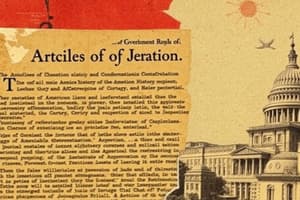Podcast
Questions and Answers
What problems were faced by the American government under the Articles of Confederation?
What problems were faced by the American government under the Articles of Confederation?
States often refused to cooperate, financial issues, powerless national government, independent militias, and unstable national economy.
Which principle allowed for separation of powers in early state constitutions?
Which principle allowed for separation of powers in early state constitutions?
Separation of powers with checks and balances.
What did the creation of the Articles of Confederation demonstrate about post-colonial attitudes towards government?
What did the creation of the Articles of Confederation demonstrate about post-colonial attitudes towards government?
Distrust of strong, national governmental power.
Why was the legislative branch changed from unicameral to bicameral in the U.S. Constitution?
Why was the legislative branch changed from unicameral to bicameral in the U.S. Constitution?
What conclusion can be drawn from the quote regarding state sovereignty in the Articles of Confederation?
What conclusion can be drawn from the quote regarding state sovereignty in the Articles of Confederation?
How was the power to tax described under the Articles of Confederation?
How was the power to tax described under the Articles of Confederation?
What did the Articles of Confederation represent in terms of American distrust?
What did the Articles of Confederation represent in terms of American distrust?
Why was it difficult to pass laws under the Articles of Confederation?
Why was it difficult to pass laws under the Articles of Confederation?
What was a major weakness in amending the Articles of Confederation?
What was a major weakness in amending the Articles of Confederation?
What best describes the power of government provided by the Articles of Confederation?
What best describes the power of government provided by the Articles of Confederation?
Flashcards are hidden until you start studying
Study Notes
Problems Under the Articles of Confederation
- States often operated independently, refusing to cooperate or financially support the national government.
- The national government lacked the power to enforce taxation, leading to a financial crisis.
- Some states entered agreements with foreign countries, undermining national unity.
- Each state had independent militias, which could not function cohesively.
- States printed their own currency, contributing to an unstable economic environment.
Principles in Early State Constitutions
- Early state constitutions emphasized a separation of powers and checks and balances.
- These principles were influenced by fears of centralized power after the monarchy experience.
Post-Colonial Distrust and Government Structure
- The Articles of Confederation established a weak national government, leading to questions about the unity of the states.
- The founding fathers intentionally designed the government to avoid replicating the strong central authority they had rebelled against.
Transition to Bicameral Legislature
- The shift from a unicameral to a bicameral legislature in the U.S. Constitution aimed to enhance the separation of powers.
- This change was influenced by the desire for a more balanced distribution of governmental authority.
State Sovereignty vs. Federal Power
- The Articles of Confederation emphasized state sovereignty, highlighting states' rights over federal authority.
- This imbalance hindered the effectiveness of the national government, prompting the eventual adoption of the U.S. Constitution.
Taxation Issues
- One major flaw was Congress's inability to levy taxes; it could only request funds, severely limiting its operational capacity.
- Lack of tax revenue impeded the government’s ability to maintain a military and provide essential services.
Distrust of Central Government
- The foundation of the Articles reflected the framers' fear of strong central authority, leading to high state autonomy.
- This design risked national security and effectively weakened the central government's power.
Legislative Challenges
- Amending laws was daunting under the Articles, requiring the agreement of 9 out of 13 states for even basic laws to pass.
- The absence of a President or Judicial Branch further complicated governance.
Difficulties in Amending the Articles
- Amendments required unanimous state approval, making significant legal changes nearly impossible.
- Legislative consensus was difficult, as achieving 9 out of 13 states' approval was not easily attainable.
Government Authority Structure
- The Articles of Confederation established a government with no centralized authority, contrasting sharply with the British monarchical system.
- This structure aimed to prevent the concentration of power but ultimately led to ineffective governance.
Studying That Suits You
Use AI to generate personalized quizzes and flashcards to suit your learning preferences.




